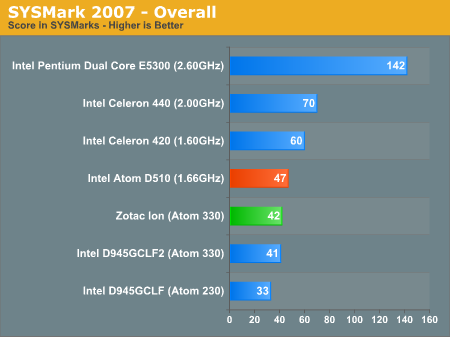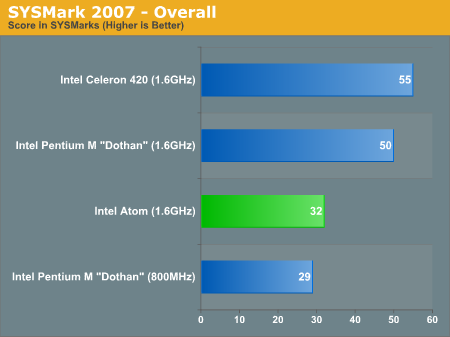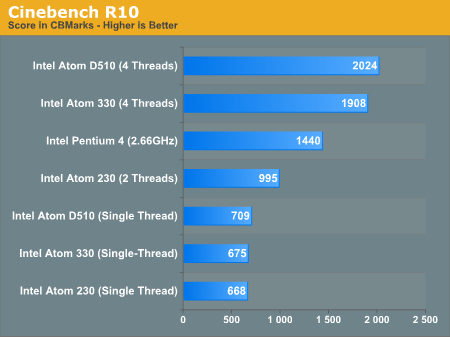Intel Atom D510: Pine Trail Boosts Performance, Cuts Power
by Anand Lal Shimpi on December 21, 2009 12:01 AM EST- Posted in
- CPUs
Performance
Across the board, thanks entirely to the integrated memory controller, Pine Trail is roughly 5 - 10% faster than the original Atom platform. The performance gain varies, but on average I’d say 5 - 10% is a reasonable expectation. It’s lower than I expected, but it looks like Atom’s performance is gated in more areas than just memory operations.

The integrated GMA 3150 feels like it handles Windows Aero a bit worse than Ion at higher resolutions, but I hear that may be a driver issue.
That 5 - 10% performance advantage does actually translate into something you can feel in real world usage. My Pine Trail system felt snappier than my older Atom machines. By no means was it fast, Atom is still slow after all, integrated memory controller or not.
Remember the comparison I did back in 2008:

At 1.6GHz the old single core Atom delivered the performance of roughly a 1.2GHz Pentium M. Thanks to the integrated memory controller I’d put the new Atom D410 at about the speed of a 1.4GHz Pentium M. The dual-core D510 is a bit more difficult to quantify. In single threaded use cases, the D510 still fits the bill as a 1.4GHz Pentium M, move to multithreaded and it’ll clearly have an advantage there.
Interacting with your PC, opening windows, launching apps, browsing the web, is generally all bound by the performance of a single thread. In those cases, you’re still looking at a platform that’s the equivalent of a low end notebook (not desktop) from 2004.

Atom has single threaded performance worse than a Pentium 4, but multithreaded FP/SSE performance can be much better on the dual core versions
The second core helps Atom not feel so slow when you’re trying to do two things at once. The second task doesn’t even have to be that CPU intensive, it could be something as simple as reading a document while you’re launching another application or opening another web page. Even in light multitasking, the second core helps.
On average, it’s still a sluggish platform. I’d take Pine Trail over the old Atom any day, but set your expectations accordingly: Atom can’t deliver the performance of a modern day machine, it’s best used as a secondary or tertiary PC.
Test Configuration
| Motherboard: | Intel D945GCLF2 (Atom 330) Intel D945GCLF (Atom 230) Intel D510MOB (Atom D510) Zotac Ion (Atom 330) |
| Chipset Drivers: | Intel 9.1.1.1011 (Intel) |
| Hard Disk: | Intel X25-M SSD (80GB) |
| Memory: | G.Skill DDR2-800 2 x 2GB (4-4-4-12) 2GB for the two Intel Atom 330/230 boards |
| Desktop Resolution: | 1920 x 1200 |
| OS: | Windows Vista Ultimate 32-bit (for SYSMark) Windows Vista Ultimate 64-bit |










41 Comments
View All Comments
Ghandalf - Monday, December 21, 2009 - link
Hi,good article!
What power-supply did you use for your tests? The idle consumption of the new d510 looks too high for me!
blackbrrd - Monday, December 21, 2009 - link
This really doesn't look very impressive, looks like we have to wait for 32nm to make the GPU usable as noted in the article...Ghandalf - Monday, December 21, 2009 - link
Hi,good article!
What power-supply did you use for your tests? The idle consumption of the new d510 looks too high for me!
dgz - Monday, December 21, 2009 - link
I am tired of Intel forcing crap products on consumers, while touting the great benefits. Clearly there is no benefit for the consumers. Not to a single one as the IGP is barely enough for Minesweeper.Although I am very disappointed with nVidia these days, their offerings are much better on the mobile segments - both phones and nettops.
zdzichu - Monday, December 21, 2009 - link
Best feature of this platform is getting back to known, supported GPU. Intel damaged its reputation with Paulsbo, now there a chance to get back to supported graphics chipset, with proper Open Source drivers.ET - Monday, December 21, 2009 - link
The difference in numbers (950 vs. 3100) made me hope there'd be some improvement in the graphics, but it was my fault for not having done enough research. Turns out they're basically the same. I forgot it was the X3100 that had DX10 graphics, not the 3100 (how nice of Intel to use such clear naming convention).Still, in other respects this seems like an okay upgrade. A little better performance and lower power. I wonder if it will make the GMA 500 solutions go away.
AmdInside - Monday, December 21, 2009 - link
I'm a bit disappointed myself in Pinetrail platform. To me, it seems more or less a way to bring costs down for Intel while masking it as a performance bump to consumers. Unfortunately, my perfect netbook is an Atom dual core with an ION chipset on a 10" screen but it does not exist. There are 12" versions but then, it somewhat defeats the purpose of the netbook (portability and battery life). I wish a 10" version would come out. It would be the perfect companion video player. I could watch Hulu in bed, take to the gym and watch movies while on the treadmill, have it beside my main PC to stream sports programs while working, play hidef movies on my hard drive to a large HDTV, etc.. Hopefully someone will create a 10" Ion notebook in the near future.bnolsen - Saturday, December 26, 2009 - link
I don't know about playing movies to hidef but I watch hulu all the time with my current netbook, on linux even. I also watch 720p encoded content, but scaled to fullscreen.Go buy the lenevo for $194 and try it.
AznBoi36 - Monday, December 21, 2009 - link
I agree with all your points, which is why I have not yet jumped on the Atom bandwagon.dagamer34 - Monday, December 21, 2009 - link
It's pretty sad to see that Intel is muscling nVidia out of this market, when it's clear that a better product exists, and now we're getting a "new" product with worse performance across the board. Because if Flash isn't being hardware-accelerated, then that means that they CPU is doing more work, and whatever gains Pine Trail might have (i'm not convinced they're even worth writing an article over), it's negated by the exponential improvement in which Ion brings to the table.At first, I thought nVidia's CEO was blowing a bunch of hot air about Intel playing hardball, but it's pretty obvious that something is wrong with this picture here. If Microsoft got smacked down for bundling in 1998, I don't see how bundling the CPU and GPU into one chip and then locking other hardware vendors out with expensive contracts is any different. And what's worse, apparently the laws this time around allow the Federal government to not just look at Intel's past actions, but their effect on the future as well.